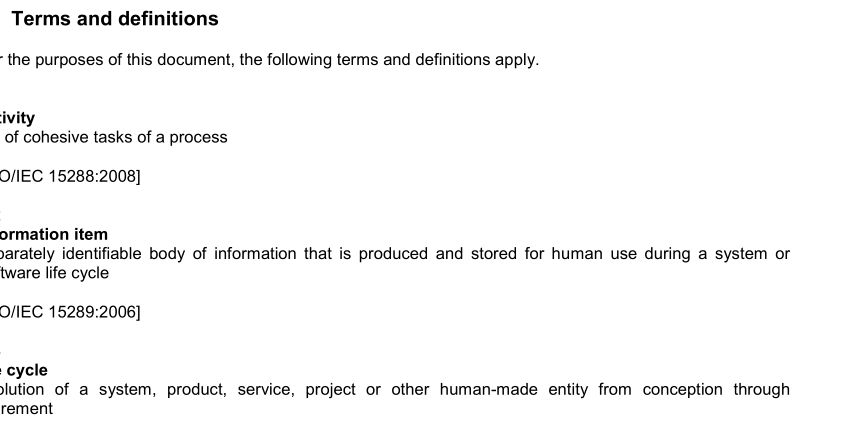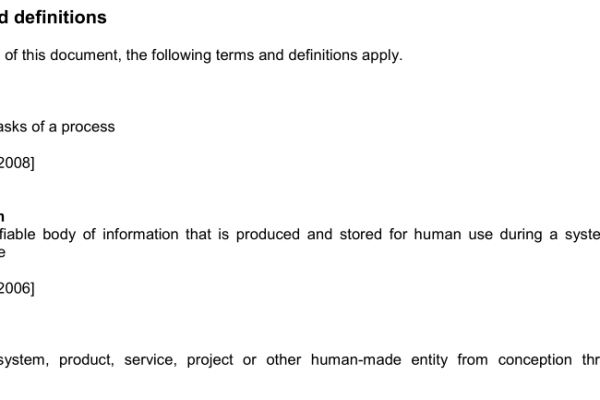ISO IEC TR 24774:2010 pdf download – Systems and software engineering — Life cycle management — Guidelines for process description.
3 Characterizing the elements 3.1 Introduction To enable uniform description additional characterization of the elements is helpful. The remainder of this Technical Report provides that characterization. This Technical Report describes the following process elements: ⎯ The title is a descriptive heading for a process; ⎯ The purpose describes the goal of performing the process; ⎯ The outcomes express the observable results expected from the successful performance of the process; ⎯ The activities are a list of actions that may be used to achieve the outcomes. Each activity may be further elaborated as a grouping of related lower level actions; ⎯ The tasks are specific actions that may be performed to achieve an activity. Multiple related tasks are often grouped within an activity; ⎯ The information items are separately identifiable bodies of information produced and stored for human use during a system or software life cycle. To prevent confusion and to encourage consistency the use of alternative terms for these elements is strongly discouraged. Figure 1 is a UML representation, adapted from Figure C.1 of ISO/IEC 15288:2008, depicting the relationships among the elements of a process as discussed in this International Technical Report. NOTE A process view has the same component entities. Annex A presents an example of a process described using the guidelines in this Technical Report.
Not all elements need to be treated in all standards. Some standards will treat only process Title, Purpose, and Outcomes, for example, leaving the activities for further elaboration by other standards. The goals and objectives of performing a process can be described by using the elements of Title, Purpose, and Outcomes. These elements are used to describe intended results without the necessity of performing structural decomposition of the process. Processes defined using Title, Purpose, and Outcomes provide a common starting point for process implementation and process assessment. NOTE The distinction between a process and a procedure is a simple one. A procedure is a set of steps to be followed that, when completed, might or might not achieve the intended objective. This is similar to following a recipe when cooking. On the other hand, a process is executed with knowledge of the intended purpose and outcomes to achieve the desired result. 3.2 The title element The title of a process description is a short noun phrase that presents a descriptive heading for the process. The title identifies the principle concern of the process and distinguishes the process from other processes in the model. Because of the latter criterion, it may sometimes be necessary to change the title of a process. For example, one might have a “software design process” which is later renamed as a “software detailed design process” to distinguish it from a newly-invented “software architectural design process”. NOTE 1 Process descriptions may be used both to describe generic objects of a particular type (for example “project management process”), and to describe a particular instance of a generic type (for example “project management process for project A”). For a process model or a standard the type description is sufficient, but in other cases (for example project planning) generic process types are instantiated with respect to resources and time. When both generic types and particular instances are described, in order to differentiate between the two a typographical convention may be adopted (for example the title of the specific instance may be set in italic font). NOTE 2 The intent is to give a title not a summary. Noun-verb or verb-noun phrases lead to an attempt to summarise the purpose or process so that the title can stand for the purpose. This is often misleading. A descriptive noun phrase – the name of the process – is less open to misinterpretation and the temptation to let it stand in for the purpose. 3.3 The purpose element The purpose of the process is stated as a high level, overall goal for performing the process. In cases where processes might be thought to overlap, the purpose should be used to characterize the scope or bounds of the process. Whenever possible, the purpose should be succinctly captured in a single sentence.
ISO IEC TR 24774:2010 pdf download – Systems and software engineering — Life cycle management — Guidelines for process description






